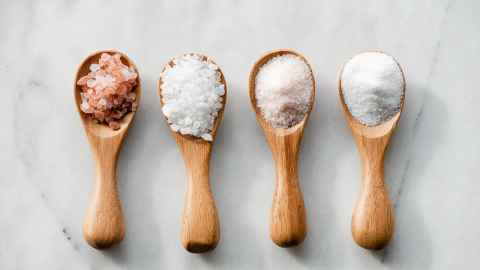Could some salts actually be good for us?
12 March 2024
Opinion: Helen Eyles provides a guide to the different salts available, rock, flakey, pink, and now potassium-enriched, and the importance of iodine.

Salt has been in the news again, with research from Australia demonstrating that potassium-rich, rather than sodium-rich, salts could lower blood pressure.
The researchers recommended that guideline bodies such as the World Health Organization review their recommendations about the use of potassium-rich salts as soon as possible. Should we be following their lead?
Ideally, yes. Potassium helps to maintain normal levels of fluid in our cells and to lower blood pressure. It is found naturally in many foods. Fresh foods such as fruit and vegetables are the main sources of potassium in the diet, but for myriad reasons, including cost, most of us don’t eat the recommended two servings of fruit and five servings of vegetables per day.
One in five adults in Aotearoa New Zealand has high blood pressure, and a key cause is too much salt, mostly from ultra-processed foods, and not enough potassium from fresh fruit and vegetables.
We need to consume a small amount of salt for our muscles and nerves to function properly, but too much of it causes our bodies to retain too much water. That extra water places pressure on our heart and blood vessels and over time can make them stiffer, which in turn leads to high blood pressure. Diets high in salt are also independently linked with chronic kidney disease, osteoporosis, and stomach cancer.
Table salt, if it’s iodised, can also be an important source of iodine if people don’t consume enough iodine-rich foods. Iodine is an essential trace element that our body needs for survival, and we must get it through our diet. It’s critical for healthy thyroid hormone production, energy use, growth, and brain development, making it particularly important during pregnancy and breastfeeding. Iodine deficiency is the most common cause of thyroid disease, specifically hypothyroidism which, among other problems, can cause goitre (swelling of the thyroid gland in the neck).
Iodised potassium-rich salts have the potential to lower sodium intake and increase potassium consumption – a win-win for blood pressure and iodine intake.
Potassium-rich salts could be a better option for the saltshaker though. A relative newcomer to the table and supermarket, products such as Mrs Rogers Lo Sodium Salt have a similar taste and mouthfeel to regular table salt but contain potassium (rather than just sodium) chloride. Iodised potassium-rich salts have the potential to lower sodium intake and increase potassium consumption – a win-win for blood pressure and iodine intake, as iodised versions of potassium-enriched salts are also available. (Though these products must be avoided by people with severe kidney disease whose potassium consumption must be closely monitored.)
Although most of us would agree salt adds flavour to food, our tastebuds can adapt to a lower salt diet. Taking the saltshaker off the table might go some way toward reducing the salt we eat, which on average for New Zealand adults is about 50 percent more than recommended. However, we shouldn’t just blame the saltshaker – we get about three-quarters of our dietary salt from ultra-processed foods such as breakfast cereals, sausages, mass-produced bread, fruit-flavoured yoghurt, ice cream, and soft drinks.
These foods have undergone significant industrial processing and contain unrecognisable substances extracted from whole foods, often with a few additives and emulsifiers thrown in to make the formulations work. Ultra-processed foods have ingredients you probably won’t find in your pantry and certainly not in your grandparents’ pantry, but which make them convenient, attractive, cheap, and easy to eat (and eat too much of). The World Health Organization recommends companies reduce the amount of salt added to ultra-processed foods as an important strategy to reduce sodium consumption worldwide.
If, through personal agency, community support, or government intervention, we manage to eat fewer ultra-processed foods, then we can probably keep the saltshaker on the table, or that wee dish of pink Himalayan sea salt or artisanal sea salt flakes, so long as we choose iodised products.
And if we are going to lower population blood pressure, it would involve finding a way (cue Government support) to encourage us to eat more potassium-rich food such as fruit and vegetables, and to be able to afford to do so.
If we were to do that and reduce our salt intake to a maximum one teaspoon a day for adults (and less for children), the research tells us we would save 235,000 Quality Adjusted Life Years (a combined measure of death and disability), and $1.26 billion.
This article reflects the opinion of the author and not necessarily the views of Waipapa Taumata Rau University of Auckland.
This article was first published on Newsroom, Could some salts actually be good for us?, 12 March 2023
Media contact
Margo White I Research communications editor
Mob 021 926 408
Email margo.white@auckland.ac.nz